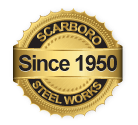Differentiating Between the Types of Plain Carbon Steel
Plain carbon steels are named as such because of the low quantities of carbon as part of their predominantly iron composition.
The presence of carbon, however small, can provide different mechanical properties depending on how much is present, leading to an assortment of fabricated products, such as shear blades or steel beams.
Plain carbon steels can be grouped into the following three forms:
≤ 0.3% Carbon: Low Carbon Steel
Steel demonstrating a carbon content between 0.1 – 0.15% can be classified as a low carbon ‘dead mild’ steel. This low quantity of carbon lends itself to the ductility (the measure of plastic deformation before fracture) and soft characteristics seen in this type of steel, meaning it can be pressed to accommodate more eccentric geometric structures.
A step up, yet still within the realm of low carbon steel, are those with a carbon content between 0.15 – 0.3%. Where, unlike its lower carbon counterpart, the soft and ductile nature is sacrificed for increased strength. This type of steel is known to be the most prevalent in the industry due to being cost-efficient throughout the manufacturing process, mostly because of its straightforward machining process.
Hot and cold working can be conducted on low carbon steels, allowing them to be used for structural sections such as I-section steel beams, reinforcing rods, sheets, strips, and wires.
0.3 – 0.8% Carbon: Medium Carbon Steel
As you might imagine, medium carbon steel demonstrates increased mechanical properties in hardness (resistance to localised plastic deformation), strength, and toughness when compared to low carbon steels. This, however, comes at the cost of increasing manufacturing expenses.
While cold working is less commonly practiced on medium carbon steels due to cracking, they are renowned for their hot working capacity, allowing for versatility in their applications throughout industry, such as spanners, wire ropes, gears, wood saws, pipe, tubes, etc.
0.8 – 1.4% Carbon: High Carbon Steel
Following with the trend previously outlined, these steel types carry an even higher manufacturing cost than the medium and low carbon alternatives. While garnering a reputation for its high mechanical strength, the increased carbon content makes for a more brittle type of steel when compared to others, making them unsuitable for instances where brittle failure is to be avoided, such as in steel beams.
Typical application for this steel type include cutting tools, wood drills, and springs.






